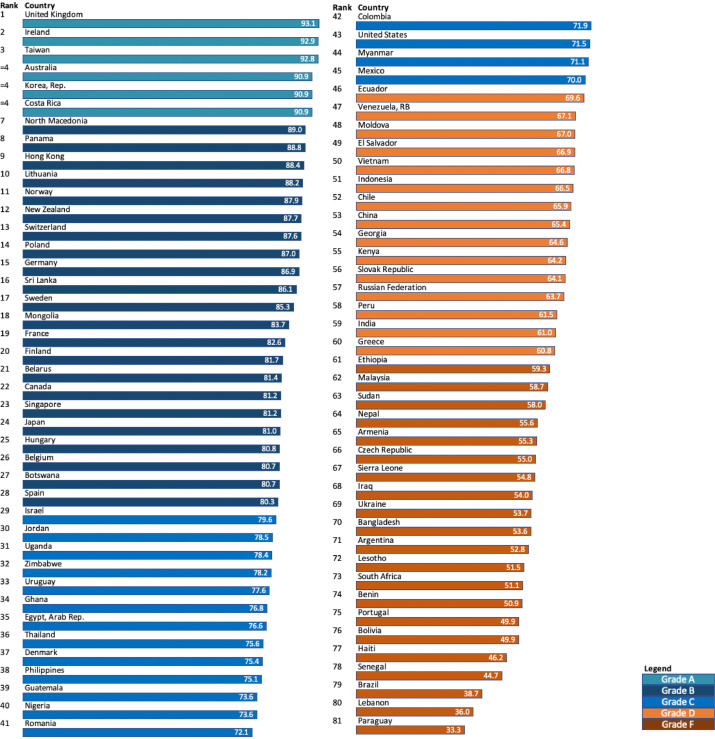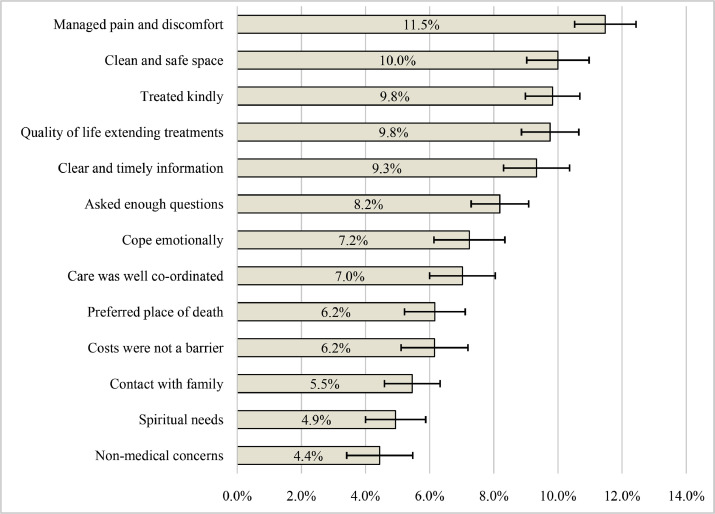Taiwan's performance has always been among the best in the global Assessment of Quality of Death and Dying. However, besides the outstanding results, the feedback and advice from these assessments are what we really should be paying attention to. We should learn from the shortcomings and continue to improve to provide those in need with our comprehensive services.
After a two-year survey, in 2021, the Journal of Pain and Symptom Management ranked 81 countries worldwide in terms of the Quality of Death and Dying. Taiwan ranked third in the world and the first in Asia. This assessment result is after two similar surveys were conducted in 2010 and 2015.

image resource: Finkelstein et al. (2021). Cross Country Comparison of Expert Assessments of the Quality of Death and Dying 2021.
In these three global ranking surveys, Taiwan consistently received favorable results. To go deep into the reasons, we can see that in terms of care, policy, economic and social environment aspects, as well as high coverage of National Health Insurance and the support from the government, are all making positive impacts. Quite frankly, Taiwan's excellent performance is worth publicizing.
Reflection and Review to Make Up for Deficiencies
Although Taiwan's performances were outstanding, we did not forget to go back and review each underperforming area. We wanted to face the problems and identify the lessons so that we can progress even further.
In 2010, the Economist Intelligence Unit (EIU) announced that it was commissioned by the Lien Foundation in Singapore to evaluate the Quality of Death Index in 80 countries and regions worldwide. What we saw in that report was not merely Taiwan’s 14th place in the overall ranking, but it pointed out that Taiwan's "Availability of End-of-life Care" is still lacking, and this aspect ranked 19th and far below the overall ranking (14th). Thus, Taiwan started to promote Type B Hospice Care[1] to increase the accessibility of the services. Over time, more and more associations were established to provide hospice care so that this weak part of Taiwan's hospice is gradually filling up.
In 2015, Taiwan's global ranking made substantial progress compared with 2010. This time, Taiwan ranked in 6th place. We were still checking the comments and found that among the 50 EIU evaluation items, Taiwan ranked a lowly 24th in the "Quality of Care for Individual Patients," "Human Resources," and "Education." Furthermore, Taiwan ranked 26th in the "Shared Decision-making" element. Although the overall 6th place ranking is worthy of applause, these low-ranking items are undoubtedly warning messages to us on the need to continued improvement.
Therefore, Taiwan has increased the importance of "Shared Decision-making," which is now listed as one of the evaluation items in the hospital’s patient evaluations. Meanwhile, we have also strengthened the medical staff and supplemented training. In just a few years, the above efforts have had noticeably positive results.
Focus on the Needs to Improve the Service
In these global ranking surveys, we did not lose sight on the high ranking, but primarily focused on our insufficiencies. According to the results, we aimed to strengthen, adjust, and make up for the weak spots. The Taiwanese government has even formulated several plans and provided funds to fully support the promotion of hospice care. As a result, since 2015, while many institutions have made significant improvements, a number of institutions are still lagging behind. No matter what, the coverage of hospice care in Taiwan still has room to improve, and yet, the hard work over the years has indeed paid off gradually.
In 2021, Taiwan took the 3rd place ranking award, which proved that we do have the ability to provide first-rate hospice care. Yet, with joy, we continue to clearly focus on those parts we can do even better.
The 13 indicators used this year were compiled from hundreds of references and focused on the top priorities for patients who need hospice care. These included pain control, clean and safe spaces, kindness and care with empathy, respect for different religions, and value for life quality over prolonging life, and etc. A total of 81 countries participated in this survey.

image resource: Finkelstein et al. (2021). Cross Country Comparison of Expert Assessments of the Quality of Death and Dying 2021.
This evaluation survey reminds us that we must understand the needs of the hospice care field by managing the quality care expectations of patients and their families. So, we must consider carefully if there is anything that is not yet comprehensive enough. Perhaps these 13 evaluation items can provide much insight to monitor the content and excellence of Taiwan's Hospice care environment.
Taiwan's hospice care currently provides a full range of services, including hospitalization, home hospice care, and shared hospice care. However, the quantity of services provided has always been a challenge to expand. That is, it has been discussed internationally that hospice care can support the late stage of life, but can the services intervene in the earlier stages also?
As for Taiwan's hospice care development, we must start with education. Whether it is policy, medical staff, medical students or the public, the concepts of hospice care should keep pace with the times. In this way, each individual can make full use of their knowledge to help themselves and others to improve their quality of life.
[1]Type B Hospice Care Institution: The government allows general health care institutions to apply as type B hospice-provided institutions, as long as the healthcare providers receive specific training, including 13 hrs of lecture and 8 hrs clinical clerkship regarding hospice. The government will reimburse the institutions for the hospice-related expenditure. There are also Type A institutions, where the training requirement will be more comprehensive.
